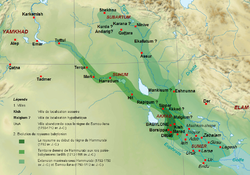Neo-Babylonian Empire
The Neo-Babylonian Empire or Second Babylonian Empire (also known as Chaldea) refers Babylonia during the 11th, or Chaldean, dynasty. The old empire was torn apart by civil wars in the middle 7th Century BC. "Chaldea" meant the southern part of Babylonia, until a Chaldean became the king of Babylon.
This new dynasty ruled between 626 BC when Nabopolassar rebelled against Assyria, till 539 BC when Cyrus the Great captured the city of Babylon. The king Nebuchadnezzar II ruled this kingdom from 605 BC - 562 BC.
Neo-Babylonian Empire Media
Map of the Old Babylonian Empire under Hammurabi (r. c. 1792–1750 BC).
Locations of some major Mesopotamian cities.
- Etemenanki Babylon (7).png
The so-called "Tower of Babel stele", depicting Nebuchadnezzar II in the top-right and featuring a depiction of Babylon's great ziggurat (the Etemenanki) to his left.
Illustration of the inhabitants of Babylon deriding the Achaemenid king Darius I during the revolt of Nebuchadnezzar III in 522 BC. From the History of Darius the Great (1900) by Jacob Abbott.
Major cities of Lower Mesopotamia in the 1st century BC.
9th century BC depiction from a cylinder seal of the Statue of Marduk, Babylon's patron deity Marduk's main cult image in the city.[1]
Cylinder by Nabonidus, commemorating restoration work done on a temple dedicated to the god Sîn in Ur. Exhibited at the British Museum.
Other websites
- ↑ Willis 2012, p. 62.








